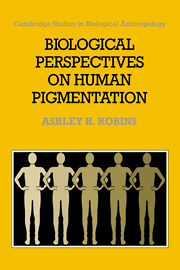Book contents
- Frontmatter
- Contents
- Dedication
- Preface
- Acknowledgements
- 1 Biology of the pigment cell
- 2 The biochemical and hormonal control of pigmentation
- 3 Ultraviolet radiation and the pigmentary system
- 4 Functions of melanin
- 5 Non-cutaneous melanin: distribution, nature and relationship to skin melanin
- 6 The properties and possible functions of non-cutaneous melanin
- 7 Measurement of skin colour
- 8 Disorders of hyperpigmentation
- 9 Disorders of hypopigmentation
- 10 Skin colour and society: the social–biological interface
- 11 The evolution of skin colour
- References
- Index
7 - Measurement of skin colour
Published online by Cambridge University Press: 02 December 2009
- Frontmatter
- Contents
- Dedication
- Preface
- Acknowledgements
- 1 Biology of the pigment cell
- 2 The biochemical and hormonal control of pigmentation
- 3 Ultraviolet radiation and the pigmentary system
- 4 Functions of melanin
- 5 Non-cutaneous melanin: distribution, nature and relationship to skin melanin
- 6 The properties and possible functions of non-cutaneous melanin
- 7 Measurement of skin colour
- 8 Disorders of hyperpigmentation
- 9 Disorders of hypopigmentation
- 10 Skin colour and society: the social–biological interface
- 11 The evolution of skin colour
- References
- Index
Summary
Measurement techniques
The scientific study of human skin colour requires accurate measuring instruments. Before the latter became available verbal descriptions of skin colour had to suffice. It is true that terms such as ‘black’, ‘brown’ and ‘white’ (or ‘blond’ and ‘brunet’) are universally understood and each can be further qualified as light, medium or dark, but verbal descriptions such as these are only really applicable to broad categories and they are not discriminating enough to identify gradations of skin colour within and between populations. In the same way, a verbal description of a green paint would be totally inadequate for the selection of an accurate colour match. Furthermore, verbal reporting relies on subjectivity and this often introduces bias and distortion. Any form of measurement which seeks scientific acceptability must use standardized methods that are not only reliable and objective but easily reproducible.
In order to meet these needs various colour-matching techniques have been devised (e.g. Gates's tinted papers). The most widely used of these has been von Luschan's skin colour tablets. These consist of a set of small ceramic tiles consecutively numbered from 1 to 36 and ranging from pure white to black. There have also been colour atlases (e.g. the Munsell system and the Medical Colour Standard for Skin) which have provided sets of standard colour chips for skin matching. However, these methods have the disadvantages not only of subjectivity but that the surface texture of the chip or tile may not resemble that of the skin (or may have deteriorated with time) so that matching becomes imperfect.
Another colour-matching method was the Bradley colour top.
- Type
- Chapter
- Information
- Biological Perspectives on Human Pigmentation , pp. 98 - 122Publisher: Cambridge University PressPrint publication year: 1991
- 1
- Cited by



